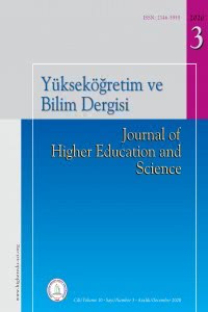İç Kalite Güvencesi ve Dış Kalite Değerlendirmesi Arasındaki Uyumun Sağlanması: Cezayir Deneyimi
İç kalite güvencesi, Dış kalite değerlendirmesi, Uyum, Üniversite programları, Eğitim
Building Congruence Between Internal Quality Assurance and External Quality Assessment
Internal quality assurance, External quality assessment, Congruence, University programs, Training,
___
- ASEAN University network quality - assurance (2004). Manual for the Implementation of the Guidelines.
- De la Rosa González, C. (2008). IQA of ANECA. In N. Comet Señal, C. de la Rosa González, F. P. Fischer, S. P. Hansen, & H. Ponds, Internal Quality Assurance and the European Standards and Guidelines (ENQA Workshop report 7, pp 15-19).
- Boele E. B. (2007). Handbook: internal quality assurance in higher music education. AEC publications.
- Key performance indicators: A guide for assessment and quality enhancement for universities in the Islamic World. Retriewed from:http://www.mohe.gov.sa/en/isesco/Documents/003. pdf.
- Vlăsceanu L., Grünberg L., & Pârlea D. (2007). Quality assurance and accreditation: A glossary of basic terms and definitions. Bucharest.
- ISSN: 2146-5959
- Yayın Aralığı: 3
- Başlangıç: 2011
- Yayıncı: Bülent Ecevit Üniversitesi (Önceden Zonguldak Karaelmas Üniversitesi)
Doktora Eğitimi ile İlgili Yaşanan Zorluklar ve Baş Etme Stratejileri: Durum Çalışması
ZEYNEP MEDİNE ÖZMEN, FUNDA AYDIN GÜÇ
SERVET ÖZDEMİR, ALİ ÇAĞATAY KILINÇ, ZEKİ ÖĞDEM, EMRE ER
İç Kalite Güvencesi ve Dış Kalite Değerlendirmesi Arasındaki Uyumun Sağlanması: Cezayir Deneyimi
Hemşirelik Lisans Öğrencilerinin Problem Çözme ve Eleştirel Düşünme Becerileri
YALÇIN KANBAY, ÖZGÜR ASLAN, ELİF IŞIK, NURHAYAT KILIÇ BAYAGELDİ
Serbest Piyasa, Bütçe ve Rekabet: Üniversitelerde Piyasa Yönelimli Yeniden Yapılanma İhtiyacı
Öğretmen Adaylarının Olumlu Sosyal ve Saldırgan Davranış Eğilimlerinin İncelenmesi
ÖZLEM GÖZÜN KAHRAMAN, GÖKÇE KURT
Suudi Arabistan’da Yükseköğretim Akreditasyonu ve Kalite Güvencesi
Yükseköğretimde Akademik Özgürlük
Üniversite Akademik Personelinin Psikolojik Dayanıklılık ve Yaşam Doyumu Arasındaki İlişki
